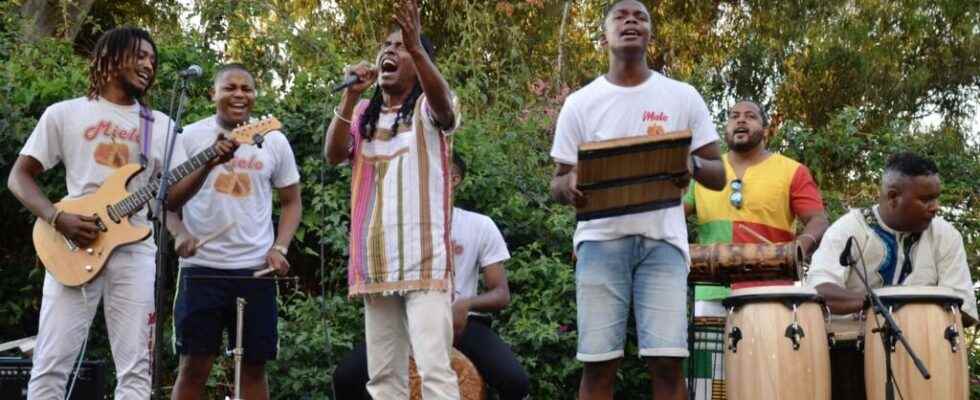Every year, on December 20, Réunion commemorates the abolition of slavery in 1848. This symbolic day has been a public holiday since 1983. A way of not forgetting the island’s past, but also of honoring ancestors and celebrate the local culture, born from the island’s plural identities.
The “20 désanm” (December 20 in Reunionese Creole, editor’s note), the other name of the Fet’ Kaf, is perhaps one of the most important dates for Reunionese, emblematic of the history of the island. and freedom returned to its inhabitants, formerly slaves. This public holiday is a big celebration on the whole of this Indian Ocean island, all the more important since it is the first time that this commemoration has taken place without any restrictions since the Covid-19 pandemic is passed by there.
Fet’ Kaf means “the feast of the Cafres” in Reunionese Creole, this word designates the population of African origin present on the island. The use of the term “kaf” is a clear claim of the African origins of Reunionese and it has been more frequently used since the 150th anniversary of the abolition of slavery on the island which took place in 1998, recalls Philippe Bessière, historian and member of the Rasin Kaf association, which promotes Reunionese culture and the memory of slavery. For him, this date is an opportunity to fully assume the history of the island and its origins “.
If the official date of the Fet’ Kaf is December 20, many events take place upstream: parades, commemorations, and kabars (festivals combining traditional music and dance, editor’s note), but also cultural mediation activities with the children. The festivities take place in the different municipalities of the island, but also in places steeped in history such as former slave camps, the Stella Matutina museum, which was once a sugar factory, or the historical museum of Villèle , one of the most important museums on the island, whose property belonged to the Desbassayns family, landowners and slaveholders in the 18th century. Today, this museum is a must-see place to celebrate the abolition of slavery and pay tribute to those who fought for their emancipation and freedom.
►To listen also: Europe: how to commemorate, explain, even repair 400 years of slavery?
Be proud of your Reunionese identity
Due to the history of the settlement of the island, the origins of the Reunionese are multiple: Malagasy, Indian, Chinese, to name but a few. For Éricka Bareigts, mayor of Saint-Denis, the celebration of December 20 is rooted in ” a process of knowledge and emancipation “. It is ” proudly claim what it means to be Reunionese, with the diversity of identities that this implies “. A way also, believes the mayor, to fight against racism and to unify all the inhabitants of the island, regardless of their origin.
Aleksand Saya, an artist from Réunion, whose music is a fusion between maloya and more electronic sounds, considers that the celebration of the abolition of slavery also makes it possible to reflect on the concept of freedom. ” This heritage that we have is highlighted during the Fet’Kaf and this allows the inhabitants of Reunion to talk about their culture, but also about their relationship with Africa which can sometimes be a little taboo. »
This date is therefore intimately linked to the roots of the people of Réunion: “ We honor our ancestors on this date which symbolizes the liberation of slaves, explains Sandra, who lives in the south of the island. It’s a date that we must perpetuate and pass on to our grandchildren so that there is continuity, so that we don’t forget history. Its very important. »
Maloya or “communion with the ancestors”
It is impossible to talk about Fet’Kaf without mentioning maloya, since this musical genre of the island, which also includes song and dance, is an integral part of Reunion’s heritage. And according to historian Philippe Bessière, it is maloya that ” allows communion with the ancestors during the commemoration of the abolition of slavery. Maloya is the music that celebrates freedom, but we must not forget that it is ” music that has long been banned recalls Éricka Bareigts. Maloya, which became a UNESCO intangible heritage in 2009, is played with friends, family or in the street and is the pride of Reunion Islanders.
Jean-Claude, member of the maloya group Mielo considers that the Fet’ Kaf is a whole: ” It is the defense of our heritage and our culture “. The Fet’ Kaf therefore appears as a celebration of the liberation of slaves, but also in a more contemporary way as the defense of Reunionese identity through music, its instruments, but also through the use of Reunionese Creole.
Olivier, a father from the town of Saint-Paul, attends the festivities every year with his family. It’s a date he often talks about with his children, aged 5 and 10 and who already know the songs of Danyèl Waro or Firmin Viry, both emblematic Maloya singers from Reunion. Maloya and Creole therefore have an important place in the transmission of Reunionese culture to younger generations.
Whether in a small committee or during large commemorations, each Reunionese celebrates the Fet’Kaf in their own way, but always in a process of sharing and celebration, so that the past is never omitted.
► To listen also: In Reunion, the maloya, from the sugar cane plantations to the international scenes
